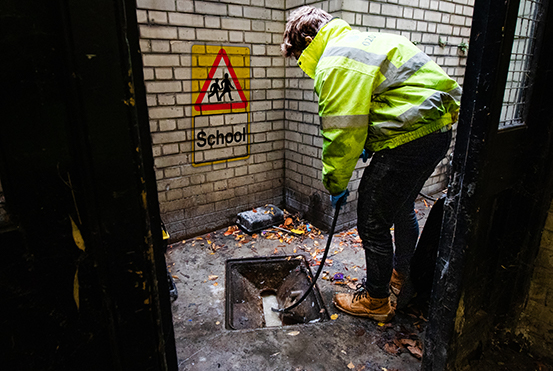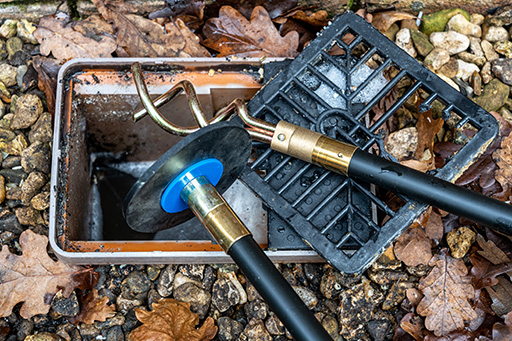Impact of Ageing Victorian Infrastructure on Drainage
Brick-arched sewers from the mid-19th century were not designed for today’s population or extreme rainfall. Limited capacity causes backflows and basement flooding, while cracks and root ingress worsen blockages and restrict flow.
Even moderate rain can overwhelm mainlines, triggering street flooding and spills, underscoring the need for modern monitoring to spot rising levels and prevent failures.
Urbanisation and Climate Change Driving Surface Water Flooding
Urban development replaces permeable ground with concrete and asphalt, markedly increasing peak runoff. At the same time, projections indicate more intense, short-duration storms that exceed older drainage design standards.
Together, these forces surcharge gullies and drains, causing localised flooding and travel disruption and accelerating wear at joints and covers, making continuous flow monitoring and dynamic outfall control essential.
Combined Sewer Overflows and Pollution in London
CSOs discharge untreated sewage and stormwater to the Thames and its tributaries when capacity is exceeded, increasing pollutant loads and harming ecosystems and public health.
Real-time level sensors upstream of CSOs can flag surcharging and trigger diversion or storage, while tracking event frequency and duration helps councils optimise maintenance and upgrades.
London Areas Most Susceptible to Drainage Failures
Flood risk maps often identify inner-city districts such as Camden, Westminster, and Southwark as hotspots due to low-lying terrain and dense, impermeable surfaces.
In outer boroughs like Hounslow and Bromley, basement flooding is a growing concern, and Docklands industrial areas face surcharge risks from runoff. Pinpointing these vulnerabilities helps specialists such as Environ target CCTV surveys and repairs to inform future smart-monitoring projects.
What Are Smart Drains and How Do IoT Drainage Systems Operate in Urban Settings?
Smart drains are conventional assets enhanced with IoT sensors, communications, and analytics, providing continuous visibility into flow, levels, and asset condition. Real-time data enables proactive interventions and long-term network optimisation.
Real-Time Monitoring with IoT Sensors
Sensors in gullies, manholes, and mains measure level, velocity, and silt accumulation, sending data via cellular or mesh networks to cloud platforms for analysis. Alerts flag abnormal trends so crews act before blockages escalate, reducing emergency call-outs and flood damage.
Sensor Types Used in Smart Drainage
Smart drainage systems typically incorporate three main categories of sensors:
Sensor Type | Measurement Focus | Key Advantage |
|---|
Ultrasonic Level | Water Height | Non-contact monitoring in manholes |
Doppler Flow | Velocity | Continuous flow-rate measurement |
Optical Clarity | Sediment and silt presence | Real-time clogging detection |
How Can Smart Drainage Solutions in London Effectively Prevent Flooding and Reduce Pollution?
Smart drainage uses data-driven controls and analytics to cut flood incidents and minimise pollutant discharges to waterways, shifting maintenance from reactive to strategic and proactive.
Flood-Prevention Benefits for Residential Properties
Street-level smart drains detect rapid water-level rises before basement flooding occurs. Sensor-triggered gully valves and temporary storage divert runoff until the network can cope. Homeowners receive notifications about surcharging, helping protect foundations, limit mould risk, and avoid costly damage.
Smart Drains to Minimise Commercial Disruption
For retail centres and industrial estates, smart drains help prevent flood-related closures to keep operations running. Predictive scheduling shifts cleaning to off-peak windows, while real-time alerts flag grease or debris. Clear drainage protects access, inventory, and business continuity.
Improving Water Quality and Reducing Sewage Overflows
Upstream monitoring of CSO chambers provides early warning of capacity issues. Data-driven coordination between storage and treatment enables controlled releases that help reduce pollutant spikes. Networks can track turbidity and other indicators to guide targeted source control and public awareness.
Predictive Maintenance and Lower Repair Costs in London
By forecasting needs from real hydraulic performance, predictive models minimise unnecessary interventions and extend pipe life. Relining and excavations are scheduled only when warranted, reducing labour and material costs.
How Do Sustainable Urban Drainage Systems (SuDS) Integrate with Smart Drainage Technology?
SuDS use green infrastructure to mimic natural drainage, promoting infiltration, storage, and evapotranspiration. Smart sensors enhance performance and simplify maintenance through continuous monitoring.
Key Components of SuDS in London
London’s SuDS include rain gardens, permeable paving, green roofs, swales, and constructed wetlands. These features attenuate peak runoff and filter pollutants. Distributed storage reduces sewer surcharge and boosts urban biodiversity, the basis of a resilient “sponge city.”
Enhancing SuDS Performance with Smart Sensors
Moisture and level sensors in permeable paving and rain gardens track storage, infiltration, and clogging. Real-time alerts prompt maintenance, clearing sediment or scheduling irrigation, so SuDS deliver flood and water-quality benefits without constant manual inspection, optimising maintenance budgets.
The Sponge City Concept and Its Benefits for London
The “Sponge City” model uses distributed green infrastructure to capture, store, and gradually release stormwater, reducing urban flood peaks and supporting groundwater recharge. In London, it aligns with the Sustainable Drainage Action Plan, improving resilience, easing pressure on conventional systems, and enhancing public spaces.
What Are the Latest Smart Drainage Case Studies and Trials in London and the UK?
Recent UK pilots demonstrate smart drainage in varied settings, offering actionable insights for wider rollout.
Thames Water’s Implementation of Smart Sewer Technology
Since 2021, Thames Water has trialled sewer-level monitors in high-risk areas, using frequent flow and level data to adjust storage and coordinate treatment, reporting reductions in CSO events in monitored zones.
Lessons from Wokingham’s Smart Drainage Pilot
Wokingham Highways Alliance deployed ultrasonic gully sensors to track silt depth and water levels. Linking data to a central maintenance dashboard enabled a shift from time-based to condition-based cleaning, reducing service visits while maintaining flood protection.
Smart Integration in the Nine Elms SuDS Project
The Nine Elms development features a major SuDS network integrating green roofs, swales, and an underground attenuation tank with telemetry. Continuous monitoring supports rapid remediation of blockages and checks pollutant-removal targets before discharge to the Thames.
How Can Property Owners Choose the Right Smart Drainage Solution for London?
Selecting the most effective smart drainage strategy requires a thorough assessment of site-specific conditions, potential risk profiles, and seamless integration with existing infrastructure and services.











